Table of Contents
Guide
Pages

Wiley Self-Teaching Guides teach practical skills in mathematics and science. Look for them at your local bookstore.
Other Science and Math Wiley Self-Teaching Guides:
Science
Biology: A Self-Teaching Guide, Third Edition, by Steven D. Garber
Chemistry: A Self-Teaching Guide, Third Edition, by Clifford C. Houk, Richard Post, and Chad A. Snyder
Math
All the Math You'll Ever Need: A Self-Teaching Guide, by Steve Slavin
Practical Algebra: A Self-Teaching Guide, Second Edition, by Peter H. Selby and Steve Slavin
Quick Algebra Review: A Self-Teaching Guide, by Peter H. Selby and Steve Slavin
Quick Business Math: A Self-Teaching Guide, by Steve Slavin
Quick Calculus: A Self-Teaching Guide, Second Edition, by Daniel Kleppner and Norman Ramsey
Basic Physics
A Self-Teaching Guide
Third Edition
Karl F. Kuhn
Frank Noschese

Copyright 2020 by John Wiley & Sons, Inc.
Previous editions copyright 1979, 1996 by John Wiley & Sons, Inc.
All rights reserved. Published simultaneously in Canada.
Published by Jossey-Bass
A Wiley Brand
111 River St, Hoboken NJ 07030
www.josseybass.com
No part of this publication may be reproduced, stored in a retrieval system, or transmitted in any form or by any means, electronic, mechanical, photocopying, recording, scanning, or otherwise, except as permitted under Section 107 or 108 of the 1976 United States Copyright Act, without either the prior written permission of the publisher, or authorization through payment of the appropriate per-copy fee to the Copyright Clearance Center, Inc., 222 Rosewood Drive, Danvers, MA 01923, 978-750-8400, fax 978-646-8600, or on the Web at www.copyright.com. Requests to the publisher for permission should be addressed to the Permissions Department, John Wiley & Sons, Inc., 111 River Street, Hoboken, NJ 07030, 201-748-6011, fax 201-748-6008, or online at www.wiley.com/go/permissions.
Limit of Liability/Disclaimer of Warranty: While the publisher and author have used their best efforts in preparing this book, they make no representations or warranties with respect to the accuracy or completeness of the contents of this book and specifically disclaim any implied warranties of merchantability or fitness for a particular purpose. No warranty may be created or extended by sales representatives or written sales materials. The advice and strategies contained herein may not be suitable for your situation. You should consult with a professional where appropriate. Neither the publisher nor author shall be liable for any loss of profit or any other commercial damages, including but not limited to special, incidental, consequential, or other damages.
Jossey-Bass books and products are available through most bookstores. To contact Jossey-Bass directly call our Customer Care Department within the U.S. at 800-956-7739, outside the U.S. at 317-572-3986, or fax 317-572-4002.
Wiley also publishes its books in a variety of electronic formats and by print-on-demand. Some material included with standard print versions of this book may not be included in e-books or in print-on-demand. For more information about Wiley products, visit www.wiley.com.
Library of Congress Cataloging-in-Publication Data
ISBNs: 978-1-119-62990-0 (paperback), 978-1-119-62991-7 (ePDF), 978-1-119-62989-4 (ePub)
Cover Design: Wiley
Cover Image: tmeks/Getty Images
THIRD EDITION
For Jonah and Sophie:
The important thing is to not stop questioning. Curiosity has its own reason for existence.
- Albert Einstein
Acknowledgments
First, I am grateful to the many John Jay High School students I've taught over the past 20-plus years. They have taught me just as much, if not more, than I taught them. The insights I've gained about how students learn science have informed the revisions for this edition.
Thanks for the tremendous help and understanding from Pete Gaughan, Riley Harding, and the rest of the team at John Wiley and Sons.
Additional thanks to Larry Ferlazzo for connecting me with the Wiley team to work on the third edition.
Frank Noschese
To the Reader
If it ain't broke, don't fix it. This maxim applies to books as well as to many other endeavors, and it explains why such a long time passed between the second and third editions of this book. Elementary physics does not change much in a few decades, and therefore this edition contains very little new subject matter.
Why a new edition, then? First, some new examples have been added, either because of change in fashions or because of new applications of basic physics. An example of the latter is the ubiquity of the smartphone, a device that didn't exist when the second edition was printed. Second, some explanations have been rewritten to improve clarity. Finally, the look of the book has been updated to make it more attractive to today's readers.
The fundamental purpose of the book has not changed, however, and if you are considering a study of this book, you probably fit into one of the following categories:
- You are enrolled in an introductory physics course and wish to have a study guide to accompany your textbook. This book follows the traditional order of topics that is used in the most popular classroom texts.
- You are taking a course that uses a nonmathematical, conceptual book as its primary text, and your instructor has adopted this book as a supplement in order to include more problem-solving in the course. The traditional order of topics in this book is also used in the most prevalent conceptual physics texts.
- You are enrolled in a course that uses this book as its primary text.
- You are not taking a formal physics course, but you wish to learn, or review, some physicsperhaps to enable you to pass a test that requires a knowledge of physics.
In any case, Basic Physics can help you. It is a complete, self-contained physics book with a programmed format. The chapters are divided into short steps called frames. Each frame presents some new material, and then asks you questions to test your comprehension. By faithfully answering the questions (preferably by actually writing the answers in the spaces provided or on a separate sheet) before you check the answers we supply, you will be able to check your progress. Learning theory tells us that by writing your answers, you understand and retain the material for a longer time. In fact, I suggest that you do not look at the answers until have completed your own. If your answer does not agree with the one we provide, be sure you understand the discrepancy before proceeding to the next frame. To check yourself further, a Self-Test, with answers, is included at the end of each chapter.
Since physics builds from one principle to another, many chapters require an understanding of previous chapters. For this reason, the prerequisites for each chapter are listed on the first page of the chapter. Some frames within chapters, however, may be skipped without disrupting the logic of the development. Such frames, which are often mathematical treatments of the subject at hand, are labeled as optional. Some optional frames have a prerequisite of a prior optional frame; such prerequisites are listed at the beginning of the frame.
I suggest that you complete the entire Self-Test at the end of a chapter before checking your answers. In this way, your test will be more similar to classroom testing. Each answer in the Self-Test section includes a reference to the frame (s) to which you should return for help on missed items.


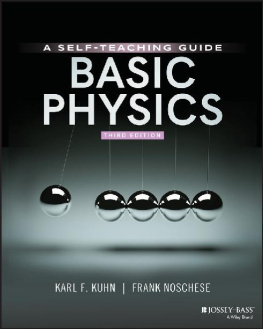

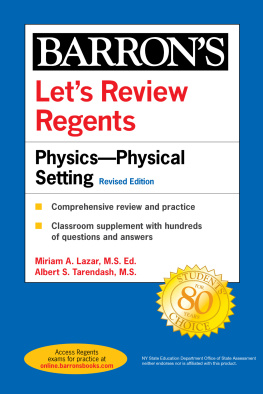
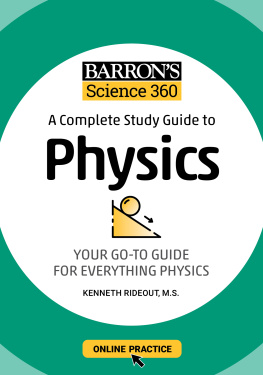
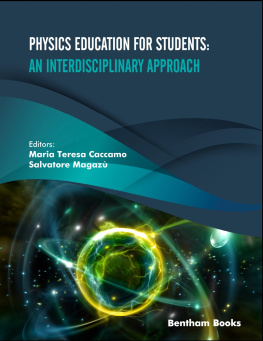
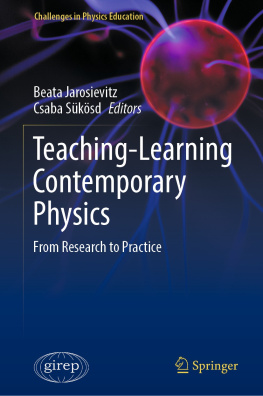
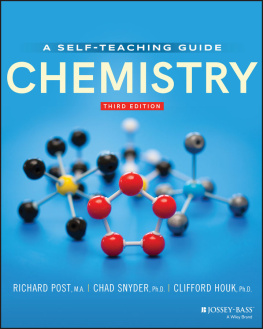


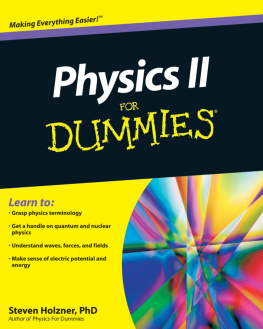
 Wiley Self-Teaching Guides teach practical skills in mathematics and science. Look for them at your local bookstore.
Wiley Self-Teaching Guides teach practical skills in mathematics and science. Look for them at your local bookstore.